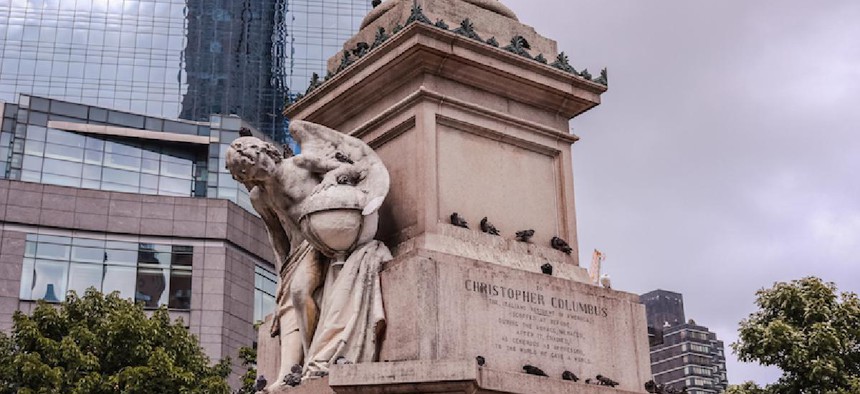When Mayor Bill de Blasio’s Mayoral Advisory Commission on City Art, Monuments, and Markers begins a series of hearings around the city on Friday, New Yorkers will be asked to testify on how to accommodate the painfully incomplete historical record that whitewashes racist and oppressive actions by those depicted.
As indigenous peoples, we must be part of that discussion.
Much of the focus rightfully has centered on depictions of Christopher Columbus, whose voyages set off centuries of genocidal exploitation of a so-called New World where tens of millions of indigenous peoples had lived for millennia.
The statues depicting Columbus ignore his enslavement and massacre of indigenous peoples, promotion of sex slavery of children and the imposition of the Doctrine of Discovery, a series of 15th-century papal bulls granting European nations sovereignty over non-Christian lands “discovered” by their explorers that continues to provide the legal underpinning of the denial of land rights to our peoples.
RELATED: Whom do we put on a pedastal
And it is not just Columbus. In a letter last month to the commission, indigenous leaders called for the removal of the equestrian statue of Theodore Roosevelt outside the American Museum of Natural History, which includes a portrayal of Roosevelt as a “Great White Father” with Native American and African-American stereotypes depicted subserviently below him.
As the sometimes violent struggles in the American South over depictions of Robert E. Lee and other Confederate generals has highlighted, history is not a static enterprise. It is said that history is written by the winners, but history changes – and is rewritten – as time exposes how hollow those earlier depictions can be.
For indigenous peoples, those depredations and degradations of the past are a living history we struggle with and against every day.
It is very much a New York City issue as well. It is often overlooked that New York City has more Native Americans living within its boundaries than any other city in the United States, more than 111,000 people according to the 2010 Census.
They are not predominantly from any one indigenous nation, but people who have come here from indigenous nations across the Western Hemisphere, what indigenous peoples call Abya Yala, or Turtle Island. New York City is a magnet for people from around the world. Names such as Manhattan and Canarsee derive from the Lenni Lenape, the original peoples of these lands.
We all live with constant struggles that plague our daily lives as we maintain our identity on occupied land. That is why we continue to push the Catholic Church and the United States government to confront the continuing devastating impacts of the Doctrine of Discovery.
Columbus’ transatlantic voyages and those that followed were protected under the doctrine, especially Inter Caetera, issued in 1493 by Pope Alexander VI as European powers began jockeying to divide up the so-called New World.
RELATED: A vision of a post-Rikers New York
As recently as 2005, U.S. Supreme Court Justice Ruth Bader Ginsburg cited the doctrine in rejecting the Oneida Indian Nation’s claim to repurchased land within its treaty established homeland, just one example of how the Supreme Court continues to rely on the doctrine to deny indigenous land rights.
We continue to hope that Pope Francis, the first pontiff from the Americas, will respond to calls for the church to rescind the doctrine and begin a healing process. While he has apologized for crimes committed by the church in subjugating indigenous peoples during a visit to Bolivia, he has not responded to calls from the United Nations and religious organizations like the World Council of Churches to rescind it.
The papal nuncio at the United Nations has told our representatives that the doctrine is ancient history. It is not ancient, but a form of living history as painful as the continuing wounds stemming from the centuries of genocidal oppression those European explorers brought to these shores.
It all started with Columbus and the process of colonization in what is today referred to as the Western Hemisphere. That is why the movement to rename Oct. 12 as Indigenous Peoples’ Day, and urging inclusion of the Doctrine of Discovery in public education curricula, is so important as part of broader work towards sovereignty, self-determination and full justice for native peoples.
And it is why we believe the Mayoral Commission on City Art, Monuments and Markers must address this living history and ongoing wounds. As an important first step, we demand these statues come down.
Betty Lyons, a citizen of the Onondaga Nation, is president of the American Indian Law Alliance. Rick Chavolla, a citizen of the Kumeyaay Nation, is board chairman of the American Indian Community House in New York City.


